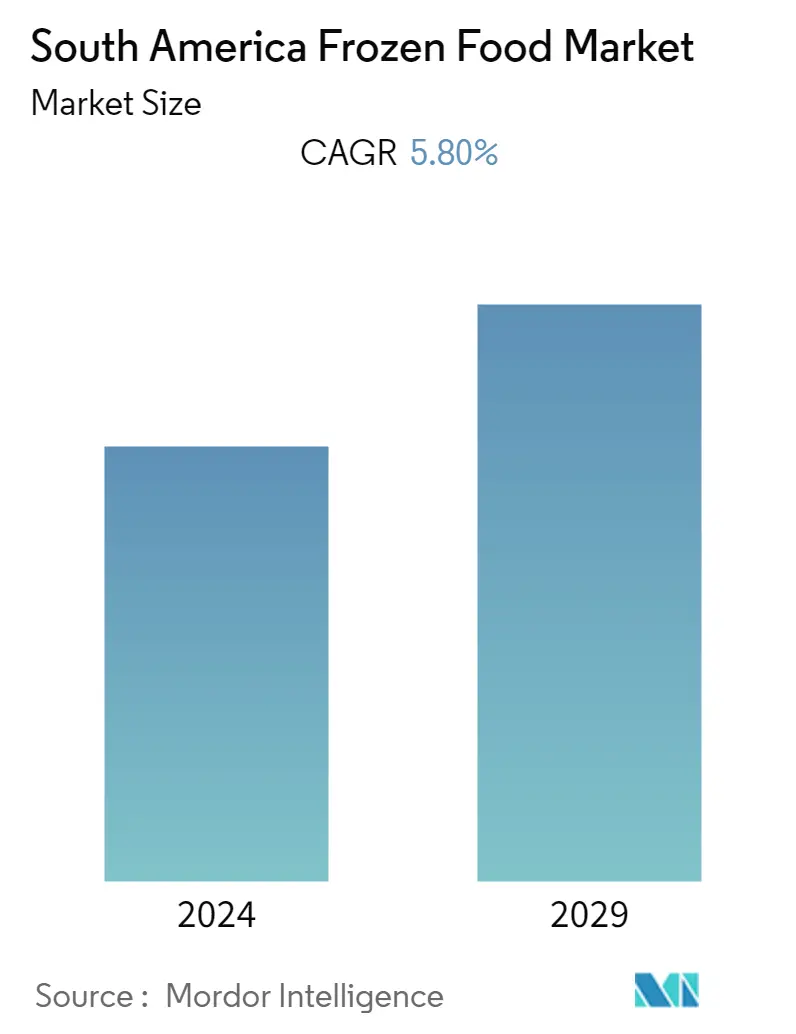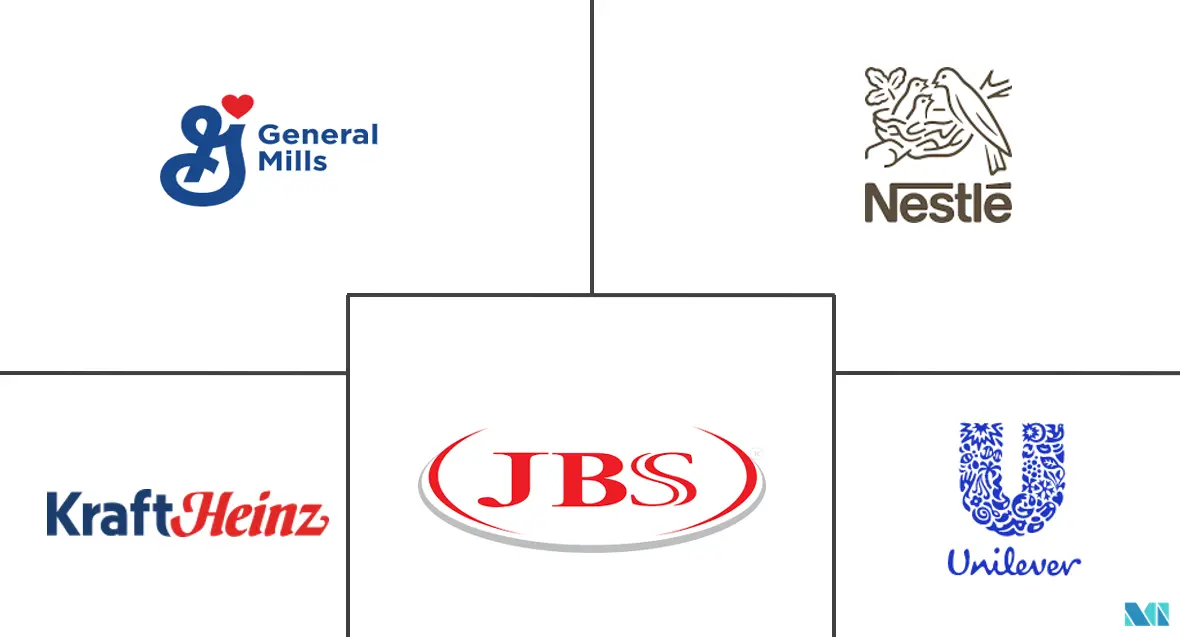Market Size of South America Frozen Food Industry

| Study Period | 2019 - 2029 |
| Base Year For Estimation | 2023 |
| Forecast Data Period | 2024 - 2029 |
| Historical Data Period | 2019 - 2022 |
| CAGR | 5.80 % |
| Market Concentration | Low |
Major Players
*Disclaimer: Major Players sorted in no particular order |
South America Frozen Food Market Analysis
The South American frozen food market is projected to register a CAGR of 5.8 % during the forecast period.
The advantages of frozen food and the strong backing for technological innovation have made the items more widely available and reasonably priced for consumers in South America. Frozen food is becoming more affordable as a result of the development of new technology. Frozen food manufacturers have been appealing to consumer demand by adding variety, innovating new flavors to make frozen foods, such as poultry, seafood, desserts, etc., more palatable, adjusting portion sizes, providing organic options, and expanding health benefits, such as fiber content. There is a shift toward demand for functional foods as consumers use food to address health issues or contribute to their overall health and well-being. Additionally, the ease of use, higher shelf life, and the busy lifestyle of consumers across the region also propel the growth of the market studied.
The COVID-19 pandemic influenced market growth as people inclined more toward foods with longer shelf lives. Supply chains also shifted production away from food service and into the retail sector. Both large and small manufacturers witnessed increased sales in 2020, but changes in packaging and distribution methods benefitted major manufacturers. Furthermore, the pandemic raised consumer demand for products that are focused on health and nutrition.
South America Frozen Food Industry Segmentation
Frozen food is defined as food products that are preserved under low temperatures and used over a long period. The scope of the report includes packaged frozen foods sold to consumers through various retail channels. The South American frozen food market is segmented by product type, product category, distribution channel, and geography. By product type, the market is segmented into frozen fruits and vegetables, frozen snacks, frozen seafood, frozen meat and poultry, frozen desserts, and other product types. By product category, the market is classified as ready-to-eat, ready-to-cook, and other product categories. By distribution channel, the market is segmented into supermarkets/hypermarkets, convenience stores, online retail channels, and other distribution channels. By geography, the market is segmented into Brazil, Argentina, and Rest of the South America. For each segment, the market sizing and forecasts are provided in terms of value in USD million.
| Product Type | |
| Frozen Fruits and Vegetables | |
| Frozen Poultry and Seafood | |
| Frozen Prepared Food | |
| Frozen Dessert | |
| Frozen Snack | |
| Other Product Types |
| Distribution Channel | |
| Supermarkets/Hypermarkets | |
| Grocery/Convinience Stores | |
| Online Retailer | |
| Other Distribution Channels |
| Geography | |
| Brazil | |
| Argentina | |
| Rest of South America |
South America Frozen Food Market Size Summary
The South American frozen food market is experiencing significant growth, driven by technological advancements that have made frozen foods more accessible and affordable. Consumers are increasingly drawn to the convenience, longer shelf life, and health benefits of frozen foods, which are being enhanced through innovation in flavors, portion sizes, and organic options. The market's expansion is further supported by a shift towards functional foods, as consumers seek products that contribute to their health and well-being. The COVID-19 pandemic has also played a role in boosting the market, as people turned to foods with longer shelf lives and supply chains adapted to focus more on retail than food service. This shift has led to increased sales for both large and small manufacturers, with major players benefiting from changes in packaging and distribution methods.
The demand for frozen foods is further fueled by rising consumer expenditure on food and beverages, the need for quick and convenient meal solutions, and the growing popularity of clean label ingredients. The market is highly competitive, with both domestic and international players like Unilever, Nestlé, and The Kraft Heinz Company leading the charge. These companies are expanding their product offerings and leveraging technological innovations to meet diverse consumer demands. The frozen pizza segment, in particular, has seen notable growth due to increased availability and the rise of organized food service players. Recent developments, such as Nestlé's plans to establish a new R&D center in Latin America and Lamb Weston's expansion of French fry processing capacity in Argentina, highlight the ongoing investment and strategic initiatives aimed at capturing a larger share of the market.
South America Frozen Food Market Size - Table of Contents
-
1. MARKET DYNAMICS
-
1.1 Market Drivers
-
1.2 Market Restraints
-
1.3 Porter's Five Forces Analysis
-
1.3.1 Threat of New Entrants
-
1.3.2 Bargaining Power of Buyers/Consumers
-
1.3.3 Bargaining Power of Suppliers
-
1.3.4 Threat of Substitute Products
-
1.3.5 Intensity of Competitive Rivalry
-
-
-
2. MARKET SEGMENTATION
-
2.1 Product Type
-
2.1.1 Frozen Fruits and Vegetables
-
2.1.2 Frozen Poultry and Seafood
-
2.1.3 Frozen Prepared Food
-
2.1.4 Frozen Dessert
-
2.1.5 Frozen Snack
-
2.1.6 Other Product Types
-
-
2.2 Distribution Channel
-
2.2.1 Supermarkets/Hypermarkets
-
2.2.2 Grocery/Convinience Stores
-
2.2.3 Online Retailer
-
2.2.4 Other Distribution Channels
-
-
2.3 Geography
-
2.3.1 Brazil
-
2.3.2 Argentina
-
2.3.3 Rest of South America
-
-
South America Frozen Food Market Size FAQs
What is the current South America Frozen Food Market size?
The South America Frozen Food Market is projected to register a CAGR of 5.8% during the forecast period (2025-2030)
Who are the key players in South America Frozen Food Market?
Unilever PLC, General Mills Inc., JBS SA, The Kraft Heinz Company and Nestlé S.A. are the major companies operating in the South America Frozen Food Market.

